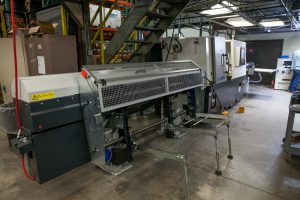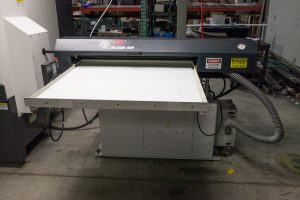The 75-year-old, family-owned business based in Lewis Center, Ohio distributes testing equipment used by construction, laboratory, food service, pharmaceutical and other industries. Recently Gilson developed a new product that separates particle sizes of granular material. This device is used by departments of transportation, civil engineering firms, and others that perform aggregates testing for construction projects such as buildings, roads and bridges. Although rotary sifters have been around for many years, Gilson’s product is completely redesigned and uses upgraded materials to provide quieter, more efficient and reliable operation.
As sales volume increased, the company decided to bring previously outsourced part production into its fledgling in-house manufacturing department. Gilson’s Vice President of Manufacturing, Phil Babka, explains, “Until 5 years ago we were strictly a distribution company and, in fact, we currently manufacture just 2 – 3% of the products we sell. However, we’ve identified certain items that we can make ourselves to reduce costs, improve quality and better manage our inventories.”
Gilson makes three versions of its rotary sifter. Each model requires six, 5/8” stainless steel rods of various sizes, each of which has its own unique features. Mr. Babka recognized that bringing production of these parts in house, and realizing the desired goals of cost-efficiency and superior quality would require a new manufacturing approach.
“When we first set up our machine shop we bought some used equipment including a manual lathe, manual milling machine, an older Okuma CNC lathe and a CNC cutoff saw. Using our existing equipment to make these rotary sifter rods would mean stationing an operator at the CNC lathe all day to constantly load material, run a part for about 30 seconds, take the part out and do it all over again. As sales began to take off, we realized that we needed a more cost-effective method capable of pumping out thousands of these parts.”
On a visit to a friend’s sheet metal fabrication shop, Mr. Babka observed an automated process that continuously feeds sheets onto a laser cutting machine, enabling lights out production. “Right then I knew what we needed.”
Mr. Babka contacted a number of machine tool suppliers and explained his requirements, “I wanted to be able to run production with minimal operator involvement during the day and run unattended overnight. So we needed to continuously feed material into a machine tool that could run the various part programs on its own, and then automatically unload the finished parts. The people who came up with the best solution were the applications engineers from Gosiger, Inc.”
To meet Gilson’s requirements, the Gosiger Applications Engineering staff ran a series of time studies to determine the most effective combination of equipment. Since lights-out production involved a large family of cylindrical parts, it was essential that both the machine tool and the material feeding system could automatically changeover from one part to another without operator assistance. And then there was the matter of automatically unloading the finished parts.
The solution Gosiger devised was a fully automated cell consisting of 4 components: 
- An LNS Quick Six S2 automatic bar feeder that uses a chain-driven loading rack holding seven, 6-foot long bars for diameters from 3/8” to 3 – 1/8” through a single guide tube that provides the support necessary for machining at high spindle speeds.
- An Okuma Genos L300-MW CNC lathe equipped with a subspindle, live tooling and the open architecture, Microsoft Windows-based OSP control that enables integration with both factory management software and peripheral devices.
- An LNS Blaze Air vacuum unloader that automatically removes parts through the back of the secondary spindle after both ends have been machined.
- The LNS e-Connect communications system coupled with the Okuma Thinc API that enables the sharing of data between the LNS bar feeder and the Okuma OSP control to maximize production efficiency and material usage.

In operation, the machine attendant fills the LNS bar feeder’s loading rack with 6-foot bar stock, selects the part programs to be run using the Okuma OSP control’s master schedule function, and starts the process. The bars are automatically fed into the turning machine’s main spindle for primary machining, then the part transfers to the sub-spindle for secondary operations. When the part is completed, the Blaze Air uses vacuum suction to unload the part through the sub-spindle and deposit it into its storage tray. All of this proceeds automatically with no operator intervention.
In addition, the LNS e-Connect system, coupled with the OSP master schedule function, makes the process even more cost-effective through its ability to automatically changeover from one part to another on the fly, and manage material usage to minimize waste.
A part library built into the LNS Quick Six S2 stores all of the bar feeder parameters for each of the part programs, and tracks material usage. Via e-Connect, the bar feeder communicates these data to the Okuma lathe’s master schedule to determine which part to run, based on available material.
The master schedule looks at how much material there is and the various part lengths. It then determines if there is enough material available to run the required quantity of a particular part run. If so, it runs the complete batch of that part. If, however, there is not enough material for the entire run, the system determines the length of any remnant, calls up the next part in the schedule that it can make from the remaining stock, and the lathe and bar feeder automatically adjust to make the new part. Once the 6-foot bar is consumed, the bar feeder loads the next bar and the system repeats the process until it makes all of the various parts in the production schedule.
The e-Connect system also uses the bar feeder’s built-in Web server to access the Internet, provide reports, and enable remote monitoring of the system. All of this makes unattended and lights-out operation possible.
According to Phil Babka, the cost of producing these parts in-house is about 25% of the cost to have them made outside. Equally important, thanks to the LNS e-Connect system and Okuma OSP control, material costs dropped dramatically – by more than 75%. He calculates that the entire automated work cell will pay for itself in approximately 5 years.
“We’re very happy with this system and are planning to add another in the near future. My advice to any shop that is considering an automation system is to make sure that, not only is the technology a good fit, but that the people you do business with will support you throughout the process. We couldn’t be happier with the applications engineers and others at Gosiger who worked with LNS to come up with exactly what we needed. Both the Gosiger and LNS teams were there whenever we needed them through installation, training and tweaking the system. I’d never heard of a Blaze Air until Gosiger suggested it, and it’s the perfect solution for unloading these parts. Likewise, the LNS e-Connect system was new to me and saves us additional time, labor and material costs.”

